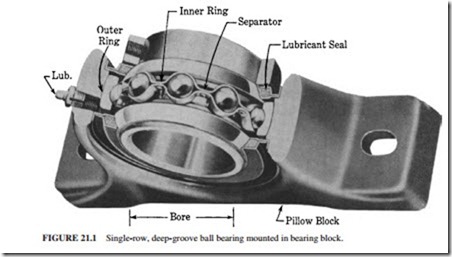The function of bearings is to keep the shaft or rotor properly aligned with the stationary parts under axial and radial loads. Bearings that provide radial positioning to rotors are known as line or radial bearings. Bearings that position the rotor axially are called thrust bearings. Thrust bearings usually serve as thrust and radial bearings.
TYPES OF BEARINGS
The main types of bearings are journal and rolling-contact (ball and roller) bearings. The ball and roller bearings are also known as antifriction bearings. The most common bearings used on centrifugal pumps are the various types of ball bearings. Roller bearings are used less often. However, spherical roller bearings are used frequently for large shaft sizes, for which there is a limited choice of ball bearings.
In horizontal pumps with bearings on each end, inboard bearings are located between the casing and the coupling. The bearing on the outside is the outboard.
The bearings are usually mounted in a housing supported by brackets which are attached or integral to the pump casing. The lubricant is usually contained within the housing. The bearings must be kept within proper temperature limits due to the heat generated within the bearings. For bearings that are provided with a forced-feed lubrication system, cooling is achieved by circulating the oil through a separate water-to-oil cooler. Otherwise, cooling liquid enters a jacket located inside the housing to remove the heat.
There are rigid and self-aligning bearings. A self-aligning bearing will adjust itself auto- matically to a change in the shaft angular position.
Ball and Roller Bearings
Since the coefficient of rolling friction is less than that of sliding friction, ball bearings offer a significant advantage over sleeve bearings. In ball bearings, the load is carried on the point of contact between the ball and the race. During normal operation (constant speed), the point of contact does not rub or slide over the race. The heat generated is mini- mal. Also, the point of contact is constantly changing because the ball rolls in the race. The bearing operation is almost frictionless.
In sleeve bearings, the surfaces are always rubbing against each other. Lubrication is used to reduce the friction.
The starting friction is only slightly larger than the operating friction in rolling-contact bearings. This is a significant advantage of rolling-contact (ball and roller) bearings. It makes them suitable for machines that are started and stopped frequently under load.
Rolling-contact bearings require little maintenance and lubrication. However, they are noisier than journal bearings and more expensive. The lifetime of rolling-contact bearings is limited due to fatigue failure of the raceways caused by the repeated high stresses as the shaft rotates. However, most failures are caused by lubrication failure or improper mounting.
Several types of rolling-contact bearings are capable of handling radial load and axial thrust. Although they are called rolling-contact bearings, the balls and rollers do considerable sliding during normal operation due to changes in speed.
Stresses during Rolling Contact
The stresses during rolling contact are high due to the small area of contact. The sliding motion (frictional force) causes tensile stress near the surface, which results in pitting. Since the contact stresses are usually greater than the yield strength, residual compressive stresses are induced in the races and the balls. These stresses cause deformations which increase with repetitions.
Since the area of contact between the balls and the races is small, the stresses in a particular point in a bearing race are very high. Fatigue failure is expected due to the repeated nature of the stresses. Figure 21.1 illustrates a single-row, deep-groove ball bearing.
Rolling bearings have a limited life because any normal loading creates stresses higher than the fatigue strength involved. The bearing life is limited by the number of stress repe- titions to cause fatigue failure. For example, doubling the speed of rotation reduces the bearing life by one-half. The centrifugal forces within the bearings become significant as the speed increases. A bearing has a shorter life at very high rotating speed.
The load has a significant impact on the bearing life. The bearing life B was found experimentally to vary inversely as the power k of the load F; B is proportional to 1/F k, where k is 3 for ball bearings and is 10/3 for roller bearings. In equation form,
Note that for ball bearings (k 3), the life increases 8 times when the load decreases by one-half. Corrosion from acid or water reduces the life of bearings.
The bearing life is usually measured in millions of revolutions (MR). However, some catalogs give the bearing life by the number of hours at various rotating speeds.
The signs of fatigue are spalling or flaking of small particles of material from the surface of a ring or a ball (roller) caused by the high shearing stress below the contact surfaces. This mechanism of failure is preceded by noisy operation. Continued operation will eventually lead to fatigue failure.

